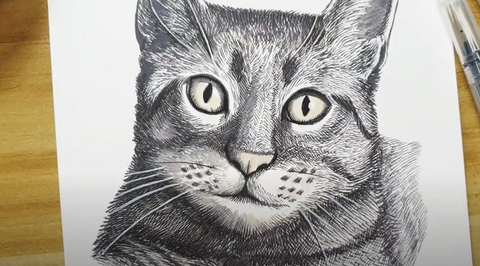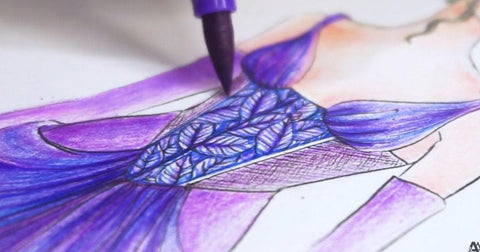Into the Creative Mind of Van Gogh: His Art, Style, and Story
Last Updated: October 13, 2025

Self-Portrait by Vincent van Gogh
If you're an artist, chances are you've been inspired by the work of Vincent van Gogh. His artwork is famous for being bold, vivid, and overflowing with emotion. Whether it was his use of color or his lively brushwork that pulled at your heartstrings, one thing is certain – Van Gogh created masterpieces that captivated millions worldwide. Today we will look into the creative mind of this prolific painter to explore his life story, creative inspirations, and unique painting style - taking a deep dive into the creative mind of one of art history's most iconic figures.
The Story of Sunflowers: Van Gogh’s Life as an Artist
On March 30, 1853, Vincent Willem van Gogh was born in the Netherlands. His mother named him after her first son, Vincent Willem, who died stillborn. Vincent was the eldest of six children. His father was a Protestant pastor, while his mother was an amateur artist who loved working with watercolors and still life. As a kid, Vincent loved to explore and wander around the countryside, admiring the colors and sceneries of nature.

Sunflowers by Vincent van Gogh
Aside from his mother's innate talent for art, Vincent van Gogh grew to be artistic due to his uncle's influence. When he was 16 years old, he became an art apprentice at Goupil and Co., where his uncle was a partner. Because of his exposure to different artworks, Vincent became highly interested in art, especially in the works of Rembrandt, Jean-François Millet, and Camille Corot. However, he didn't immediately become the painter we know today - in fact, he went through many professions before becoming a full-fledged artist. He worked as a language teacher, lay preacher, bookseller, and even a missionary worker.
It wasn't until an incident in 1880 in Belgium that Van Gogh quit his job as a missionary worker and began to delve into pursuing drawing seriously. In 1881, he studied drawing at the Brussels Academy. Eventually, in the late period of 1881, he settled in The Hague to gain more experience and tutelage from his cousin-in-law, Antonio Mauve, the painter.
It is well known that Van Gogh's parents weren't supportive of his artistic career and vehemently encouraged him to take up other professions. However, Vincent found himself deeply unhappy in these positions. To add to his dismay, the love of his life, Kee Vos, rejected him.
So, he left his parent's house, turned to art, and lived in The Hague. During this period of his life, he went to Antonio Mauve's studio every day to learn the basics of drawing, watercoloring, and oil painting. He also visited many museums to deepen his education and met with other painters.

Cafe Terrace at Night by Vincent van Gogh
From 1881 to 1890, Vincent van Gogh traveled to different places - from wanting to be isolated in nature in Drenthe to discovering his brushwork style in Paris. His work also underwent a lot of changes. He was influenced by a number of factors, such as the academies he stayed in, the painters he stayed in touch with, and the sceneries he observed. He loved working outside, and he even eventually wanted to develop an artist community at his Yellow House in Arles.
In Paris in 1887, he met the artist Paul Gauguin, who became his artist friend and roommate. The two lived harmoniously for a while until the time came that their creative differences outweighed their friendship. Consequently, it is with a fight with Paul Gauguin that the famous story of Van Gogh cutting his ear off happened.
Generally, Van Gogh struggled with a lot of mental illness and struggles during his lifetime. Not only was he malnourished, but he also had alcoholic tendencies. He suffered epileptic attacks, delusions, depressive episodes, and breakdowns. It is believed that he had bipolar disorder, borderline personality disorder, anxiety, insomnia, and schizophrenia. He had to be hospitalized many times, with most of his paintings being made at Saint-Rémy-de-Provence, a mental asylum.
Vincent van Gogh suffered a lot financially, mentally, and emotionally. He was constantly scraping by, spending most of his funds on canvas, oil, brushes, and art materials. He had to rely on his younger brother, Theo, for financial support. Throughout many years, Theo helped sustain Vincent enough for him to continue making his art. Sadly, Van Gogh never received acclimation for his art when he was alive. Experts believe that he only sold one painting during his career. Many of his paintings were lost and even thrown away by his mother. It was only in 1892 that his work got its one-person show. Since then, his work has been auctioned off for huge sums and received a lot of praise for its expressive colors and distinct painting style.

Irises by Vincent van Gogh
Painting With Emotions: Van Gogh’s Style and Technique
Even though he was primarily self-taught, Van Gogh's painting style and technique are remarkable and unique, stemming from his creative influences and own emotions. For most of his paintings, he used the impasto technique, thickly lading the canvas with paint. This technique created the distinct brush strokes we know his "Cypresses" and "The Garden of Daubigny" has, for example. He made such bold color palettes and textured strokes by painting directly from the tube. He didn't utilize a palette but most likely used palette knives or brushes once he applied the paint directly on his canvas. He also liked plein-air painting, which is the act of painting outdoors.

Wheat Field with Cypresses by Vincent van Gogh
He worked with various mediums, choosing to work with whatever materials were available for him. Although he is generally known for his oil paintings, he also made a lot of iconic watercolor art. However, his brush strokes are less apparent in watercolors because he initially used them to color his sketches. However, his watercolor paintings are still recognizable as his because of their unique and bold colors. He also dabbled with lithography, with "The Potato Eaters" being one of his most infamous art.
Overall, his work mainly demonstrates a one-of-a-kind mixture of techniques, such as pointillism, impasto, plein-air painting, and post-impressionism.
How the Sun Compelled Vincent to Paint: Van Gogh’s Works
Vincent van Gogh is one of the most talented and recognizable painters in history, largely thanks to his iconic works. Among Van Gogh's most famous paintings is "Starry Night," depicting an intriguing night sky filled with stars, "The Bedroom," a cozy, homely picture of Van Gogh's bedroom, and "Sunflowers," a vibrant bouquet of sunflowers that have captivated viewers for decades.

The Starry Night by Vincent van Gogh
Be Inspired by Van Gogh and Take Up Your Own Brush Today!
Vincent van Gogh, the go-to master of post-impressionism, is one of the world's most prolific and influential artists ever to exist. His art serves as a timeless inspiration for generations of artists that continue to admire his work today. Though Van Gogh endured a career of hardship and financial struggles, he never succumbed to these difficulties and continued to make art for as long as he was alive.

Bedroom in Arles by Vincent van Gogh
He channeled his talent through nearly 2,000 paintings alone during a 10-year span, making Van Gogh one of the most prolific painters in history. Through tone, color, form, and vivid expressionism, Van Gogh captured raw emotion and inspired many due to his desire to pursue success within the creative arts. Even though his life was one of pain and suffering, his paintings continue to bring comfort and happiness and will forever be remembered in the history of art.






